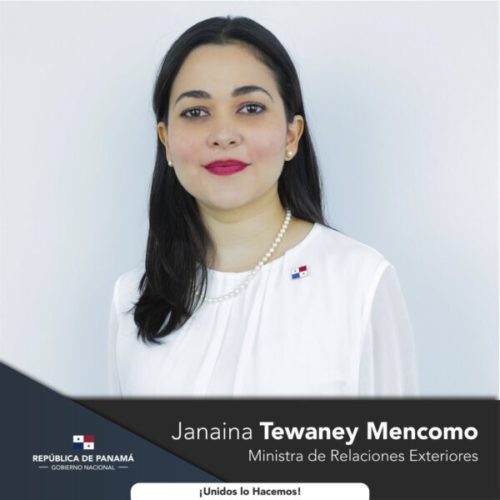THE MINISTRY OF FOREIGN AFFAIRS OF PANAMA

Janaina Tewaney Mencomo
Minister of Foreign Affairs
The Chancellor of the Republic was born in Panama on July 14, 1984. She is a graduate of the University of Panama. She has a degree in Law and Political Science; She holds master's degrees in Public International Law from the Free University of Brussels (Université Libre De Bruxelles), and Law of Arbitration, Mediation and Dispute Resolution, University of Hong Kong (Hong Kong University). She speaks Spanish, English, French and Hindi.
She held the position of advisor to the senior office in the Ministry of Foreign Affairs, responsible for the foreign policy strategies of the Republic of Panama, in matters related to security and official missions of the President of the Republic.
She served as an independent consultant in International Trade and International Politics in Mumbai, India.
She was an International Policy Analyst on terrorism financing, creating geopolitical scenarios on issues of security and water diplomacy, for Strategic Foresight Group, an international think tank based in Mumbai, India.
She also worked as an Academic Research Analyst on issues of: International Humanitarian Law, Nuclear Disarmament, Mediation and International Arbitration, Chemical and Conventional Weapons at the University of Hong Kong.
In the Ministry of Commerce and Industries of Panama, she worked as a Negotiating Lawyer in the Free Trade Agreements between Panama and its commercial partners in labor, environmental, financial services and foreign investment issues in Panama.
Zoom on
Bolívar Palace
Historical background...
At the end of the 17th century, part of the building now called the Bolívar Palace was built. At that time it was the Franciscan convent. After the independence of Spain in 1821, it was expropriated by the government of New Granada and became a military barracks, a hospital for foreigners, the Simón Bolívar Institute and La Salle College.
Important events took place at the Palace of Bolivar, such as the amphyric Congress convened by the Liberator Simón Bolívar in 1826 or the drafting of the first Constitution of the Republic of Panama in 1904.
In 1999, the Bolivar Palace was designated to conform to Panama's Agreement with the United Nations, which declared the meeting room of the Franciscan convent a World Heritage site in 1997.
During the 10th Ibero-American Summit in 2000, the meeting room was inaugurated. The Protocols of the Isthmus, the original documents of the Amphictyonic Congress, as well as replica of the sword "Espada Sol" used by Simón Bolívar friendly gesture of Venezuela, is here. The original of the sword "Espada Sol", designed in carat gold and with 1374 diamonds, is in Venezuela and was a gift from Peru to the Liberator.
The Bolivar Palace has a neocolonial architecture and is the headquarters of the Ministry of Foreign Affairs since 2003.
The Bolivar Museum
The Bolivar Museum is protected from the weather by a glass camera and has 2 exhibitions.
Archaeological discoveries
During excavation work in the central courtyard of the convent, part of the original 17th-century structure, known as "Las Crujías" (underground canals carrying water), was discovered.
The four pavilions
In the center of the Bolivar Palace, a square in honor of the Liberators and all those who fought for Latin American independence, was built. In its center is "Rosa de los Vientos" which leads to each of the pavilions of the palace.
The four pavilions that the Bolivar Palace is composed are:
• Joan of Arc (1921)
• Juan Bautista de La Salle (1926)
• Constitution (1931)
• Centenary (2003)
The Bolivarian society of Panama
Founded in 1926 at the Pan American Congress commemorating the centennial of the Amphictyonic Congress of 1826.
This congress approved the founding of the Bolivarian Society in all the nations of Latin America, to venerate the memory and the ideals of the Liberator.
The Bolivarian Society of Panama was established by a founding act of July 20, 1929, and is located in the Jeanne d'Arc Pavilion.
 Consulate General of Panama
Consulate General of Panama 
